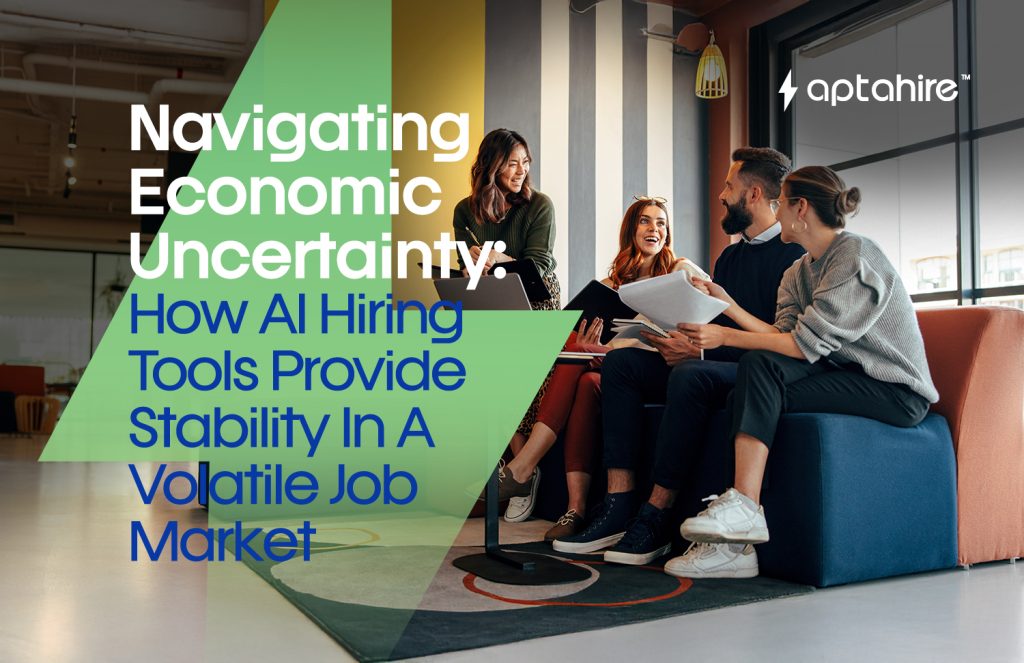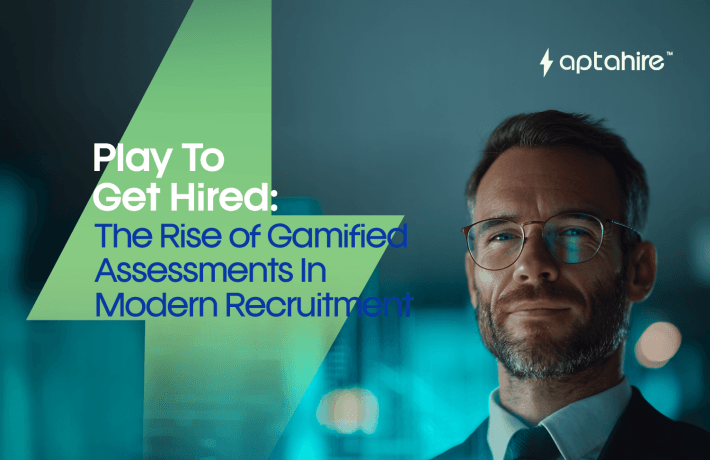Navigating Economic Uncertainty: How AI Hiring Tools Provide Stability in a Volatile Job Market

Introduction
If you’re an HR professional, you’ve likely felt the pressure of managing recruitment during unpredictable economic shifts. One month you’re scaling up, and the next you’re dealing with hiring freezes or layoffs. It’s an exhausting cycle. As someone who’s been in HR through both booms and downturns, I can confidently say the landscape has changed, and we need smarter tools to keep up. AI-powered hiring platforms are no longer optional. They’re becoming essential for stability.
AI isn’t just a shiny new tech trend. It’s transforming how we hire, especially when conditions are shaky. From automating resume reviews to helping forecast future talent needs, these tools make recruitment more strategic, structured, and consistent. In this blog, I’ll walk you through exactly how AI hiring tools help us weather economic storms, and why now is the time to integrate them.
Where Traditional Hiring Falls Short in Tough Times
Traditional hiring depends heavily on human effort and judgment. During a market downturn or unexpected hiring spree, that process quickly falls apart. I’ve seen it firsthand: overwhelmed teams, rushed decisions, and overlooked candidates. Here’s what typically goes wrong:
- We react instead of plan due to unclear hiring forecasts
- HR teams burn out trying to keep up with volume
- Manual screening causes bottlenecks
- Stress amplifies bias in hiring decisions
In volatile times, these issues don’t just slow you down, they cost you good talent and budget. That’s where AI comes in.
How AI Adds Stability to Your Recruitment Process
AI tools are helping us move from reactive chaos to proactive control. Here’s how they provide the consistency we desperately need:
- Workforce Forecasting AI platforms can analyze historical data, market trends, and industry shifts to help us forecast hiring needs. This kind of visibility lets us build pipelines in advance and avoid last-minute scrambles.
- Fast and Fair Resume Screening Using NLP (natural language processing), AI tools can review thousands of resumes in seconds and match them with the role based on skills, experience, and context. It’s not just faster, it’s smarter.
- Behavioral and Skill-Based Insights AI interviews can pick up on tone, clarity, and facial expressions to help gauge soft skills and cultural fit. When you combine that with technical assessments, you get a 360-degree view of the candidate.
- Minimizing Bias One of the most valuable things AI brings to the table is consistency. The best platforms are trained on diverse data and follow the same logic every time, which helps reduce unconscious bias during high-pressure situations.
- Real-Time Metrics and Support Dashboards showing time-to-hire, quality scores, and funnel health allow hiring teams to make better decisions fast. No guesswork, just actionable insights.
Case Study: How Aptahire Helped a Manufacturing Giant Adapt
Let me share a quick real-world example. A large automotive parts manufacturer in India was hit with a sudden surge in demand in early 2024. They had 45 days to hire over 300 skilled workers. Their old-school process just couldn’t scale.
They turned to Aptahire.
With Aptahire’s video interview platform and automated screening features, they processed over 9,000 applications in just two weeks. The AI shortlisted candidates based on technical skills, adaptability, and communication. HR didn’t have to manually review every profile, and the final interviews were scheduled seamlessly.
The results?
- Time-to-hire dropped from 21 to 7 days
- Screening accuracy improved by 70%
- Candidate dropouts fell by 40%
- Every step was logged for audit readiness
That kind of stability during peak stress is a game-changer.
What the Data Tells Us
Here are some industry insights that support what many of us in HR are already seeing:
- 67% of hiring managers say AI saves them significant time (LinkedIn)
- Companies that use AI reduce cost-per-hire by an average of 35% (Gartner)
- Candidate satisfaction improves by up to 60% thanks to faster communication and feedback (SHRM)
Tips for HR Leaders Navigating Uncertainty with AI
- Maintain a Warm Talent Pool Don’t wait for a hiring spree to start building your database. Use AI to tag and organize profiles based on roles, experience, and readiness.
- Automate the Admin Work Let AI handle screening, scheduling, and follow-ups. Free your team to focus on interviews, culture fit, and internal collaboration.
- Combine Human Judgment with AI Precision Use AI for first-round interviews and assessments, then let your managers make the final call. It’s about balance, not replacement.
- Use Metrics to Build Your Business Case Show leadership the value of your hiring strategy. AI tools can provide concrete data on hiring efficiency, candidate quality, and cost savings.
- Communicate Better with Candidates AI chatbots and automated updates can keep applicants in the loop, which boosts your employer brand, even when hiring is paused.
Final Thoughts
Uncertainty is part of today’s hiring reality. But that doesn’t mean we have to feel out of control. AI hiring tools like Aptahire help HR teams stay efficient, fair, and confident, no matter what the economy throws at us.
The future belongs to those who can adapt. By leveraging AI, we make hiring less reactive and more strategic. Whether you’re dealing with a hiring freeze, a sudden spike in applications, or pressure to do more with less, AI gives you the structure to keep moving forward.
As HR professionals, it’s time we start thinking of AI not just as a tool, but as a partner in building a resilient, agile workforce.
FAQs
- What is economic uncertainty in 2025?
Economic uncertainty in 2025 is driven by several global factors, including ongoing geopolitical conflicts, fluctuating inflation rates, shifting monetary policies, and the residual impact of supply chain disruptions. The United States is navigating tariff adjustments and reshoring efforts, while Europe is dealing with energy instability. Developing countries like India face challenges balancing growth with inflation. All these factors make business forecasting, especially hiring, unpredictable.
- What is the economic trend in the world in 2025?
In 2025, the global economic trend is cautiously optimistic yet volatile. Many economies are transitioning from recovery mode into stabilization, but risks remain. The push for domestic manufacturing, green energy investments, and AI integration are shaping industrial growth. Meanwhile, sectors like automotive, logistics, and retail are experiencing sudden spikes in hiring due to automation and localization trends.
- How do you navigate economic uncertainty?
Navigating economic uncertainty requires data-backed decisions and scalable systems. For HR leaders, this means leaning into AI hiring tools for predictive analytics, automating repetitive tasks, and building agile talent pipelines. Scenario planning, diversifying skill sets in the workforce, and reducing hiring lead times are essential strategies. Organizations that adopt tech-forward hiring practices gain resilience amid change.
- What is the future of India’s economy in 2025?
India’s economy in 2025 shows strong domestic demand, driven by infrastructure spending, a growing middle class, and government-led initiatives like ‘Make in India’. However, global volatility and inflation continue to influence sectors like IT, manufacturing, and real estate. Hiring in India is shifting towards automation-readiness and skill-based evaluations, with startups and enterprises alike embracing AI for cost-effective scalability.
- Will there be a financial crisis in 2025?
As of now, a global financial crisis is not predicted for 2025, but localized recessions and sectoral slowdowns are possible. Rising interest rates and public debt in some economies are stress points. For recruiters, this means being prepared for hiring freezes in some sectors while managing bulk hiring surges in others. Agility and technology will be key to balance.
- What is economic uncertainty?
Economic uncertainty refers to unpredictable changes in macroeconomic indicators like GDP growth, inflation, interest rates, and employment. It affects business investments, consumer confidence, and hiring patterns. For HR teams, it often results in budget constraints, shifting workforce needs, and fluctuating hiring volumes. Leveraging AI helps mitigate these effects through automation, predictive insights, and scalable hiring models.



